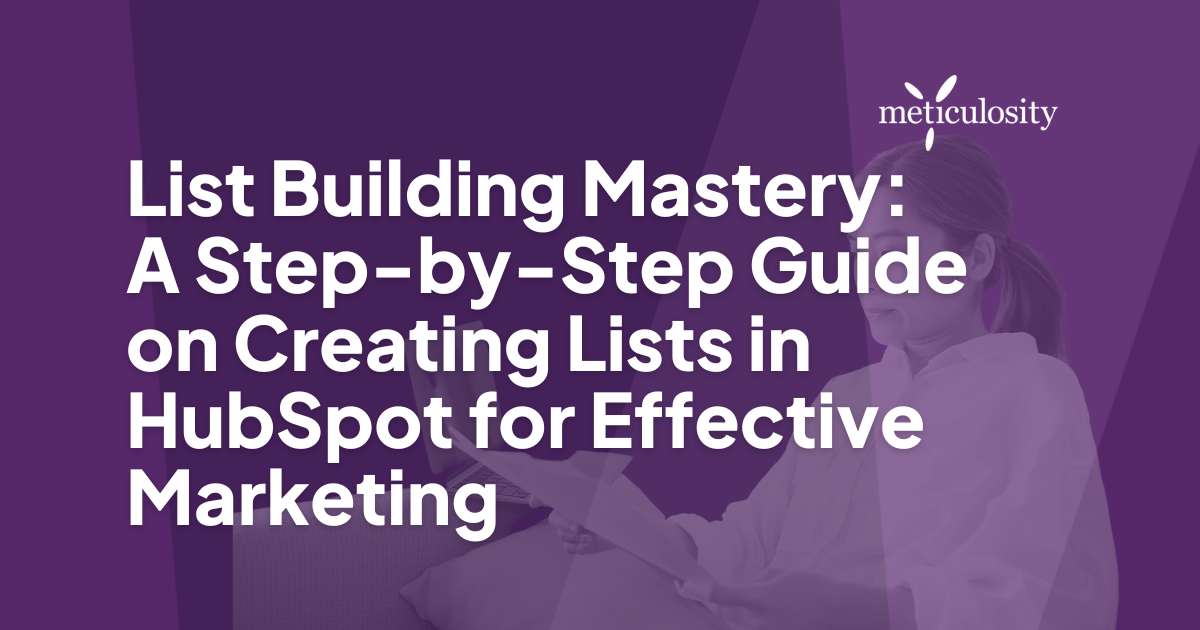Do you ever feel like your marketing efforts are a shot in the dark with broad, undifferentiated contact lists? It's a common challenge—attempting to craft that perfect message for a wide array of varied audiences.
But let’s let numbers do the talking: HubSpot reveals that campaigns tailored through segmentation can boost revenues by a staggering 760%. In this guide, we will walk you through crafting effective and pinpointed lists within HubSpot step by deliberate step.
Key Takeaways
- HubSpot's Lists Tool allows for easy and effective organization of contacts based on behavior, preferences, and interactions.
- Creating lists in HubSpot involves defining specific criteria and naming and saving the list with a clear purpose, which is crucial for targeted marketing.
- Advanced features such as segmenting, filtering, adding/editing list members, and integrating lists with workflows and campaigns ensure more personalized and efficient marketing strategies.
- Best practices like understanding the target audience, utilizing dynamic lists for automatic updates, and regularly reviewing/updating lists are essential for successful marketing campaigns.
The Importance of Lists in HubSpot
Lists in HubSpot are a big deal for your marketing. They help you sort out all your contacts so you can talk to the right people at the right time. Think about it as putting everyone into groups where they fit best.
For example, if someone just signed up on your website, they go into one group. If another person buys something from you, they land in another group.
This kind of organization ensures that each email or ad matches what each person likes or needs. It's like knowing who wants chocolate and who prefers vanilla before handing out ice cream cones at a party! Plus, with lists, you can see how well your messages work because you're talking more directly to folks who care about what you have to say.
Steps to Create a List in HubSpot
Choose specific criteria for your list and save it for future use.
Choose Criteria for Your List
To create a list in HubSpot, you need to think about who should be on it. Ask yourself what makes your best customers alike. Maybe they all bought the same product or signed up for your newsletter at a certain time.
Use these shared things to make rules for your list. You could pick people by the emails they open, the pages they visit on your website, or how often they buy something.
Making good choices here is like finding pieces for a puzzle. The better the fit, the clearer the picture of your audience becomes. If you sell dog food, maybe you want a list of pet owners who read your blog posts about healthy eating for dogs.
With clear criteria, HubSpot helps you assemble lists that meet each group's needs and interests.
Name and Save Your List
When naming and saving your list in HubSpot, be clear and specific. Use a name that accurately describes the criteria and purpose of the list for easy identification later on. For example, if you're creating a list of leads who have interacted with a specific email campaign, you might name it "Email Campaign A Leads." Then, save your list to ensure that all the criteria and filters are set correctly before finalizing.
This step ensures that your list is accurately saved without any errors.
Remember to utilize keywords related to contact segmentation, customer database organization, and email marketing optimization when naming and saving your lists in HubSpot to enhance their visibility within your marketing data analysis efforts.
Looking to optimize HubSpot for your business? Learn how to improve here.
Advanced Features for HubSpot Lists
Segmenting and filtering your lists allows for more targeted and personalized marketing. Adding and editing list members gives you control over who receives your messages. Learn how to maximize these features in HubSpot for effective list management!
Adding and Editing List Members
When managing your lists in HubSpot, adding and editing list members is an essential step for effective marketing. Here are some steps to help you add and edit list members in HubSpot:
- Navigate to your HubSpot account's "Contacts" tab and select "Lists" from the dropdown menu.
- Choose the list you want to edit or add members to, and click on the list name.
- To add new members to the list, click the "Add contacts" button and search for the contacts you want to add. You can also import a list of contacts from a CSV file.
- Once you have added new members, you can edit their details by clicking on their names within the list. From there, you can update their contact information and properties or remove them from the list if necessary.
- To edit existing list members' criteria, click the "Edit criteria" button within the list settings. This will allow you to refine your list by adding or removing specific criteria based on your marketing goals.
- Use the "Filter options" feature to segment your list further by applying additional filters such as contact properties, email engagement, and more.
- Ensure all added and edited list members meet your target audience criteria and align with your marketing objectives before finalizing your updated list.
- Regularly review and update your lists based on changes in your marketing strategy or target audience preferences for maximum effectiveness.
Integrating Lists with Workflows and Campaigns
Integrating lists with workflows and campaigns in HubSpot can streamline your marketing efforts. By using lists as criteria in your workflows, you can automatically enroll or exclude contacts based on their list membership.
This helps create targeted and personalized campaigns tailored to specific segments of your audience. Additionally, integrating lists with campaigns allows for more efficient email sends, ensuring that the right message reaches the right people at the right time.
Seamlessly integrating lists into workflows and campaigns saves time by automating processes while delivering more relevant content to your contacts. This enhances engagement and improves the overall effectiveness of your marketing strategies.
Best Practices for Effective List Management
- Know Your Target Audience: Understanding your audience is crucial for effective list management. It's important to segment and filter your lists based on the specific criteria that align with your target audience.
- Dynamic Lists: Utilize dynamic lists to automatically update and add/remove contacts based on set criteria, ensuring that your lists are always up-to-date.
- Regularly Review and Update Lists: Keep an eye on the performance of your lists and regularly review/update them to ensure they remain relevant and effective for your marketing strategies.
Know Your Target Audience
Understanding your target audience is crucial for effective list building in HubSpot. It starts with defining your ideal customer and their specific needs, preferences, and pain points.
Utilize data from previous interactions to create detailed buyer personas so that you can segment and personalize your lists accordingly. By knowing your target audience inside out, you can tailor your email marketing strategies to provide value and relevance at every touchpoint, leading to higher engagement and conversion rates.
With a deep understanding of your target audience, you can create highly targeted lists that resonate with the recipients. This allows for more personalized communication, better relationship management, and increased chances of driving successful marketing campaigns.
Dynamic Lists
Dynamic Lists in HubSpot are a powerful tool for automatically updating your contact lists based on specific criteria. With dynamic lists, you can save time and ensure your marketing efforts are always targeted at the right audience.
By setting up rules and conditions, you can create dynamic lists that continuously adjust to include new contacts or remove those who no longer meet the set criteria. This feature helps keep your contact database organized and ensures that your marketing campaigns reach the most relevant audience, leading to better engagement and conversions.
Using dynamic lists is an efficient way to streamline your list management process and maintain an updated contacts database without manual intervention. By leveraging this feature, you can stay focused on delivering personalized content and offers to the right people at the right time, ultimately boosting the effectiveness of your marketing efforts while maximizing results from email marketing automation and inbound marketing strategies.

Tips for Creating High-Quality Lists in HubSpot
Understand Your Goal: Before creating a list in HubSpot, you must understand the specific goal or objective you want to achieve with your marketing efforts. This will help you tailor your list criteria and segmentation accordingly.
Understand Your Goal
To create high-quality lists in HubSpot, start by understanding your goal. Whether it's to nurture leads, personalize content, or improve targeting for specific campaigns, knowing the purpose of your list will guide your criteria and segmentation.
Take time to define what success looks like for each list and align it with your overall marketing objectives. By clearly understanding your goal, you can tailor your lists to effectively support lead generation, customer retention, and conversion optimization efforts.
When creating lists in HubSpot for effective marketing strategies, it's crucial to define clear goals that align with broader marketing objectives. Understanding the purpose of each list helps tailor segmentation and criteria to achieve specific outcomes such as lead nurturing and personalized content delivery.
Define Your Buyer Persona
To create effective lists in HubSpot, defining your buyer persona is crucial. Understanding who your ideal customers are helps in targeting the right audience and tailoring your marketing campaigns accordingly.
Start by gathering information about your existing customers, such as their demographics, behavior patterns, and pain points. Utilize this data to create detailed buyer personas that represent your target audience accurately.
By doing so, you can ensure that the lists you build align with the needs and preferences of potential leads or customers.
A clear understanding of your buyer persona enables you to segment contacts effectively based on their specific characteristics and interests. This targeted approach enhances the relevance of your marketing efforts and increases engagement with your audience.
Utilize Custom Properties
When creating lists in HubSpot, utilizing custom properties to personalize and categorize your contacts effectively is important. Custom properties allow you to gather specific information about your contacts that align with your marketing goals.
You can tailor your content and campaigns to better engage with your contacts by defining custom properties based on your target audience and buyer persona. Whether it's capturing industry-specific data or tracking customer preferences, utilizing custom properties enhances the effectiveness of your lists and ultimately improves your marketing strategies.
Common Mistakes to Avoid When Creating Lists
Neglecting to understand your audience can lead to ineffective list creation. Keeping your lists updated and using accurate information for successful marketing campaigns is crucial.
Not Understanding Your Audience
When creating lists in HubSpot, neglecting to understand your audience can lead to ineffective marketing and wasted efforts. Gathering detailed information about your target audience, such as their demographics, behavior, and interests, is crucial.
By understanding your audience, you can tailor your content, offers, and messaging to better resonate with them. Utilize custom properties in HubSpot to capture specific details about your contacts that will help you segment and personalize your marketing efforts effectively.
Failing to comprehend the needs and preferences of your audience could result in sending irrelevant content or offers, ultimately leading to a disengaged contact list. Regularly review and update your lists based on your audience's changing behaviors and preferences to ensure that you deliver valuable and timely content.
Not Keeping Lists Updated
Many marketers make the mistake of not regularly updating their contact lists in HubSpot. This can lead to sending marketing materials to outdated or incorrect contacts, harming your marketing efforts and wasting resources.
By not keeping lists updated, you may miss out on reaching potential customers or target the wrong audience with your marketing campaigns. Regularly reviewing and updating your lists is essential for maintaining accurate and effective contact management in HubSpot, ensuring you target the right audience with relevant content.
It's crucial to stay vigilant about keeping your lists updated to maintain accurate customer information and improve the effectiveness of your marketing strategies. Regularly purging outdated contacts and adding new leads will help keep your lists fresh and ensure you're reaching the right people with your marketing messages.
Using Inaccurate or Outdated Information
Using inaccurate or outdated information can harm your marketing efforts. It can lead to sending the wrong message to your audience, resulting in disengagement and potential damage to your brand's reputation.
Always ensure that the data you use for creating lists in HubSpot is current and accurate, as this will help you effectively target and engage with your audience through personalized and relevant content.
Inaccurate information can also cause wasted resources on ineffective marketing campaigns, so reviewing and updating your lists to maintain their quality regularly is crucial.

Conclusion
In conclusion, mastering list building in HubSpot is crucial for effective marketing. By understanding the importance of lists and utilizing the tools available, you can create targeted lists to reach your audience.
Integrating these lists with workflows and campaigns will further enhance your marketing strategies. Remember to follow best practices, utilize advanced features, and avoid common mistakes to ensure high-quality list creation in HubSpot.
With these steps in place, you'll be on your way to optimizing your email marketing efforts and increasing your conversion rates.
Click here to learn more about HubSpot marketing.
FAQs
1. How can I create a list in HubSpot to segment my contacts?
-
- Navigate to Lists: Go to the "Contacts" section in your HubSpot portal and select "Lists."
- Click "Create a list": Click the "Create list" button to start the list creation process.
- Define Criteria: Specify the criteria for your list using various properties, behaviors, or engagement metrics.
- Save and Review: Save your list, give it a meaningful name, and review the preview to ensure it captures the desired contacts.
- Use and Update: Once saved, you can use the list for targeted marketing, sales outreach, or reporting. HubSpot automatically updates lists based on the defined criteria.
2. What criteria can I use to create a segmented list in HubSpot?
-
- Contact Properties: Segment contacts based on properties like location, industry, or job title.
- Behavioral Criteria: Use engagement metrics such as website visits, email opens, or form submissions.
- Lifecycle Stage: Segment contacts based on where they are in the buyer's journey, such as leads, customers, or opportunities.
- Custom Properties: Utilize custom properties to capture specific information relevant to your business.
- List Memberships: Create lists based on existing list memberships or exclusions.
3. Can I create dynamic lists that automatically update based on changing criteria?
Yes, HubSpot allows you to create dynamic lists that automatically update based on changing criteria. Dynamic lists are handy for ongoing segmentation. When creating a list, choose a "Dynamic list." Set the criteria, and HubSpot will continuously update the list to include contacts that meet the specified conditions. This ensures your lists remain current and relevant without manual updates.
4. How can I use the created lists in my marketing and sales efforts?
Once you've created lists in HubSpot, you can leverage them for various purposes:
- Targeted Email Campaigns: Send personalized email campaigns to specific segments based on list criteria.
- Sales Outreach: Use lists to prioritize outreach to leads or contacts that meet specific criteria.
- Reporting and Analytics: Analyze the performance of different segments by applying lists to your reporting dashboards.
- Workflow Triggers: Integrate lists into marketing automation workflows to trigger specific actions or communications based on contact behavior.
- Lead Nurturing: Implement targeted lead nurturing campaigns by creating lists that align with specific stages of the buyer's journey.
Lists in HubSpot are versatile tools that empower you to tailor your interactions with contacts, streamline processes, and enhance the effectiveness of your marketing and sales strategies.







